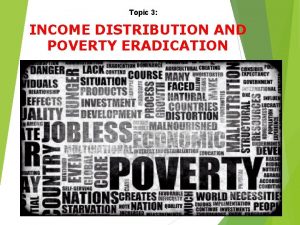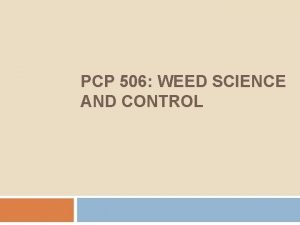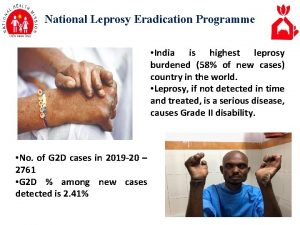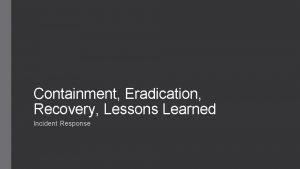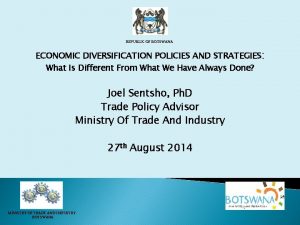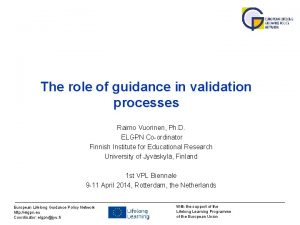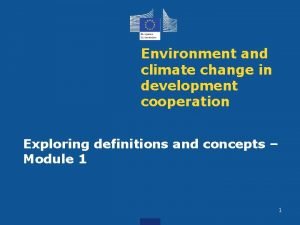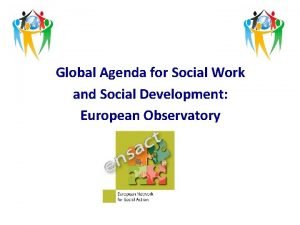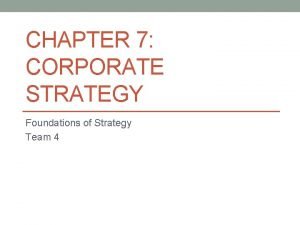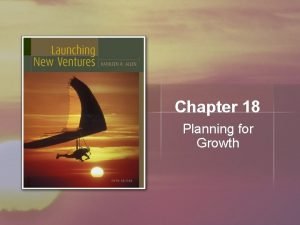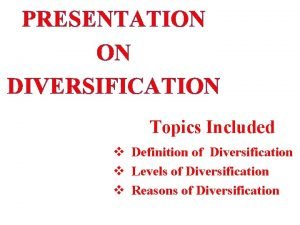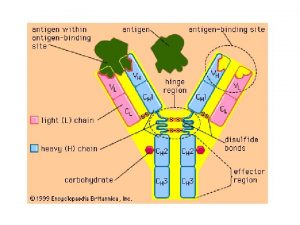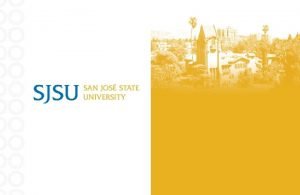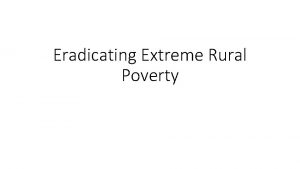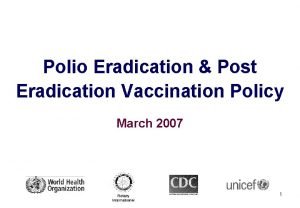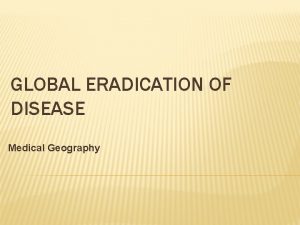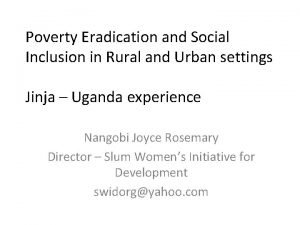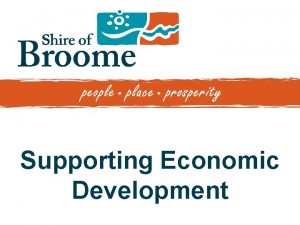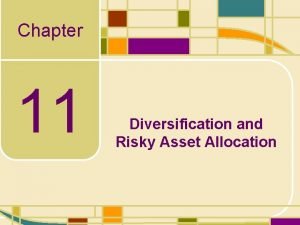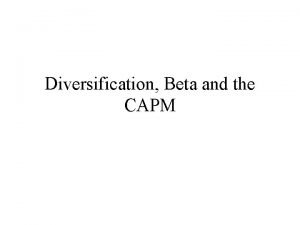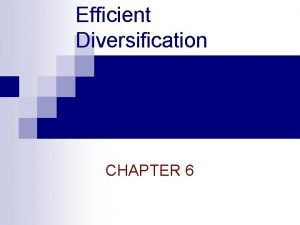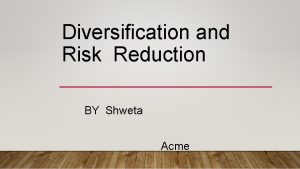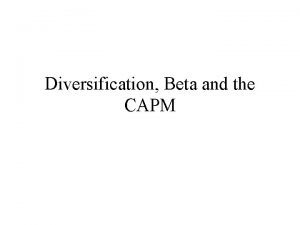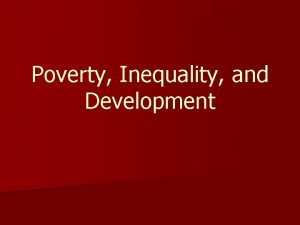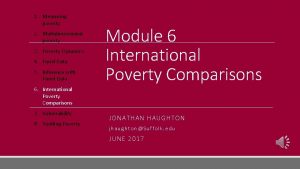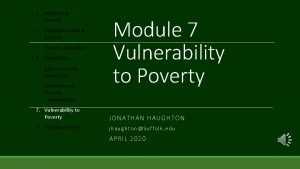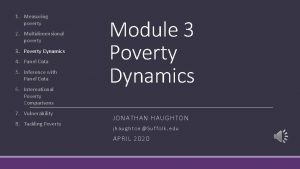Economic Diversification Social Development and Poverty Eradication in





















- Slides: 21

Economic Diversification, Social Development and Poverty Eradication in Botswana: Towards an Integrated Model of Social Protection. Prof. R. Mupedziswa, Ph. D University of Botswana Presented at “Are Diamonds there Forever ? ” Conference, Lansmore Hotel, Gaborone. 27 -28 August, 2014. e.

Organisation of Paper �Introduction �Formal social protection system in Botswana �Shortfalls of the formal social protection system �Sustainability concerns � The case for a social development perspective �Non-formal social protection system �Interface - formal/non-formal systems �“Diversification” through an integrated model? �Concluding remarks

Basic Argument of Paper �The paper argues that the government of Botswana has over the years promoted a social protection system which is the envy of many sister countries in the SADC region. The measures have had a major positive impact in respect of the fight against poverty. However, since the social protection system in place is highly dependent on revenue from the country’s mineral wealth, particularly diamonds, long term sustainability of the social protection system has been questioned. The paper makes a case for the integration of formal and non-formal (traditional) social protection systems, to come up with a social development perspective of social protection which ultimately promotes self reliance (as opposed to giving of handouts).

Introduction �At independence in 1966, Botswana was a poor country with its people depending on subsistence economy (in particular cattle/beef. �Judicious use of mineral resources since the mid 1970 s transformed the country’s fortunes, later resulting in Botswana attaining middle income status. � Over the years, Botswana has done quite well economically compared to several other SADC countries as can be noted from several basic socioeconomic indicators (See Table 1).

Selected Socioeconomic indicators of SADC Countries 2010 (Go. SA, 2010) HDI GINI Access Coefficient to Average% real GDP per Improved GDP Growth capita (PPP) water 1990 – 2008* US$ 2006** Angola 0, 564 58. 64 51% 6, 28 4, 631. 44 Botswana 0. 694 60, 96 96% 5, 32 13, 474. 95 DRC 0, 389 44, 43 46% -1, 15 295. 24 Lesotho 0, 514 52, 5 78% 3, 93 1, 183. 81 Madagascar 0, 543 47, 24 47% 2, 74 879. 43 Malawi 0, 493 39, 02 76% 3, 92 694. 57 Mauritius 0, 804 - 100% 4, 88 10, 446. 49 Mozambique 0, 402 47, 11 42% 6, 41 782, 57 Namibia 0, 686 74, 33 93% 4, 41 6, 009. 12 Seychelles 0, 845 42, 0 87% 3, 63 18, 972. 52 South Africa 0, 683 57, 77 93% 2, 68 9, 150. 58 Swaziland 0, 572 50, 68 60% 3, 56 5, 202. 86 Tanzania 0, 530 34, 62 55% 4, 79 1, 164. 30 Zambia 0, 481 50, 74 58% 2, 61 1, 241. 92 Zimbabwe N/A 50, 1 81% -0, 51 9. 65

Introduction (Continued) �In the early years, government efforts focused mostly at economic growth (Ntseane & Solo, 2007). �With time, it became apparent that economic growth alone would not be a sufficient condition for total eradication of poverty (Seleka, et al. , 2007). �The government of Botswana then made deliberate efforts to introduce a formal social protection system (social safety nets) for welfare improvement (Ntseane & Solo, 2007).

Formal social protection system Botswana �Ellis, Devereux & White (2009) have grouped the social protection measures into 4 broad categories: �(1). Food and basic needs deprivation of the extremely poor, the destitute, and older persons (e. g. Destitute P. Programme, Orphans & Vulnerable Children. , etc. ). �(2) Low yields and other natural disasters (e. g. Ipelegeng (Ntseane & Solo, 2007). �(3) Impact of HIV & AIDS on households. (e. g. CHBC). �(4) Income and assert depletion resulting from retirement, sickness, death. (E. g. Pension scheme).

Type of Targeting Program Mechanism &Number of transfer Coverage Type of Value & Governme Expenditu Social protection system-Botswana group me Beneficiaries frequenc y nt of re of Botswana transfer Annual per beneficiar y expenditu re Destitute Poor and Proxy means National; Food and Food P 450 P 214 m P 5, 596 Persons destitute cash (2008/09) Program individuals referral by (2010), me unable to community almost work rural P 254 m P 5, 286 (2008/09) -testing + representati 40, 865 – 750, Cash P 81 all monthly ves Orphan Under 18 s Categorical Care without a + referral by 119 registered school fees, P 450 -700 Program biological me or adoptive representati parent community National 48 Food; orphans uniform, (2008/2009) ves Food: monthly; etc. ; other: clothing variable Food School All school Categorical National; Variable; 1 Primary Secondary feeding children in Primary 261, 513 meal schools P 820 Prim/Sec Governmen ; Secondary daily; P 208 m; (2009/10) t school 165 RADS 2 Secondary meals; P 135 m borders 3. (2009/10) Variable, P 216 m 097; (2009/10) Vulnerabl Adults and Categorical National e group pre-school 239, 985 normally feeding (2009/2010) monthly children at Food P 35 (2009/10) nutritional risk Old Age All citizens Categorical; Pension aged 65+; National; Cash register with 91446 P 220 P 337 m P 3, 688 Monthly. (2009/10) P 359 P 30 m Monthly (2009/10) Variable P 32 m P 775 (2008/2009 (2008/09) DSS through (2009/10) local authority World War 2 Veterans WW vets, Categorical; National; or beneficiary 2940 surviving register with Vets Cash WW 2 P 10, 250 spouse or DSS through (2009/10) children local below 21 authority Remote Geographica Area communiti l + proxy in 64 Dwellers es; Basarwa means settlements in developme ) individuals 7 districts Ipelegeng testing 42, 597 mainly Infrastruct ure nt; grants +categorical (2008/2009) for income community generation Able- Self- bodied selection; in 19, 431 person- National; Cash (P 24/day (2009/10) adults principle for needing available to (2009/10) supervisor low-waged all, s) employme rotated nt when over- years but P 18/day P 221 m P 11, 384 (2009/10) 22 -day cycle subscribed Communi Very ill Categorical National Food, Food up P to ty Home- individuals referral by 14130 transport, based doctors 2004/5; 3702 counseling, P 500(P 120 2008/9 rehabilitati 0 on feeding) Care tube Monthly 2005 53 P 14, 265 million (2008/09) (2008/9)

Shortfalls of the formal social protection system in Botswana. �Alleviation of hunger rather than providing sustainable livelihoods (Gadibolae (2010). �Lack of scope to graduate out of schemes, hence creates dependency syndrome (Ntseane & Solo, 2007). �Challenges with targeting, coordination, and implementation deficiencies (Ntseane & Solo, 2007; Mupedziswa & Ntseane, 2012; BIDPA & World Bank, 2014).

Shortfalls (continued) �A recent Social Protection Assessment study by BIDPA in conjunction with The World Bank noted that, “While Botswana has many social protection programmes, some of them are rather small relative to the target group they intend to cover or to the number of poor people, which limits their effectiveness” (Balise, 2014). �The same study reportedly noted that safety net programmes were fragmented, are implemented by different government ministries, in the process diluting scarce administrative capacity.

Sustainability Concerns. �Despite the shortfalls, Botswana’s social protection system remains quite impressive, by SADC standards. �The authoritative South Africa-based Regional Hunger & Vulnerability Programme (RHVP) (2011) noted that Botswana has a very impressive track record in terms of long standing commitment to state-led social protection. . �Work by other researchers (e. g. Mupedziswa & Ntseane, 2012 a, b) has corroborated the observation that Botswana has indeed done well in regard to commitment to rolling out welfare improvement measures.

Sustainability concerns (Continued) �The Social Protection Assessment study by BIDPA/WB (2014) indicated that the government spent P 5. 3 billion on its social protection programmes in the fiscal year 2012/13. �This figure, which represents 4. 4% of GDP, is very impressive and the government ought to be commended for such commitment. � However, concern has been expressed over long term sustainability of the social protection system, especially since emphasis is on giving of handouts.

Case for social development approach �The existing social protection system predicated on remedial approach (handouts), though noble, should be viewed as only a short term measure since it is ‘relief’-oriented. �For the long term, the government may wish to consider ways of working towards promoting the social development perspective. �The social development approach emphasises capacity building and empowerment towards self reliance (Elliot, 2012). �The approach appreciates the connection between social and economic goals, and stresses the idea of planned change. Social justice is adjudged critical. (Hall, 1990).

Lessons from the River Story � The analogy by the American social organiser of the last century, Saul Alinsky of the ‘River Story’ might be instructive in appreciating the need for a social development perspective. � The analogy of the leaking water tap too corroborates the need to promote a social development approach. � The Chinese saying about catching fish is moulded along similar lines………. .

Non-formal social protection system �The non-formal system may be the missing ingredient towards realisation of the social development approach. �Traditionally Botswana depended on non-formal social protection measures, steeped in people’s cultural beliefs, norms and values, with botho spirit playing a key role. �Social groups (e. g. community, kinship ties, family, etc. operated on basis of such values as (e. g. self-help, inherent solidarity, etc )(Olivier, Kaseke & Mpedi, 2008).

Non-formal social protection system (examples) �Tribal granaries (defalana), milkpad cattle (kgamelo), tribal fields (masotla), all of which fell directly under regulation of the Chief. �Self-organised mutual support systems e. g. mafisa (lending cattle to the poor) ; go tshwara teu or bodisa (poor looked after rich people’s cattle in return for a cow); majako (poor worked in field of rich in return for portion of harvest); letsema/molaletsa (voluntary work for poor), etc. �Modern-day non-formal social protection initiatives include burial societies; credit and savings associations.

Interface between formal & nonformal social protection systems Type of Vulnerability Formal Social Protection Non-Formal Social Initiatives Protection Initiatives Food and basic needs deprivation Destitute Persons Programme of the extremely poor, the Remote destitute and older persons Area Extended family Dwellers Neighbourhood Programme support Vulnerable Groups Feeding Chiefs granary Programme School Feeding Programme Needy Students Allowance Food and basic needs deprivation Old Age Pension Extended family of older people World War II Veteran Scheme Neighbourhood support Chiefs granary Impacts of HIV and AIDS Orphan Care Programme Burial societies Community Home Based Care Savings and Credit Associations Low yields and other natural Ipelegeng Majako disasters Labour based Drought Relief Letsema Programmes Extended family Retirement, sickness, Government Pension Scheme Extended family occupational injuries and death Health Insurance Schemes Burial Societies Workmen’s Compensation Neighbourhood Maternity Benefits Support Savings and Credit associations

Diversification of social protection systems through their integration ? �The non formal social protection system essentially ‘persists’ in Botswana today essentially because it still has an important role to play. �RHVP (2011) has expressed concern that while Botswana has developed an impressive social protection system, only a small segment of the population does benefit. �Concern has also been voiced over such issues as inadequacy and restrictive nature of the provisions in the formal social protection system.

Diversification through integration (continued) �It is for these and related reasons that the paper proposes integration of the formal and non formal social protection systems. �Ideally debate should focus on which initiatives from the two systems are amenable to integration and which aren’t. �If the idea of integration were to be taken on, the first step would probably be to identify those initiatives with potential, and then find ways of building synergies between them. �As Diagram 1 shows, integration is not an end in itself, but rather should be viewed as a means to an end (i. e. realisation of the social development approach and ultimately poverty eradication.

Integrated social protection model: Steps towards poverty eradication Formal social protection system Integrated approach - Social developmental orientation - Capacity build - Self-reliance - Poverty eradication Non-formal social protection system

Concluding remarks �Government of Botswana has done extremely well in terms of commitment to state-led social protection initiatives. �However questions have remained regarding long term sustainability of the initiatives. �There is however need for an integrated approach which would bring together the formal and non formal social protection systems. �The idea would be to promote a social development approach which in turn would help build capacities for self reliance, and ultimately poverty eradication.
 Types of poverty
Types of poverty H pylori eradication therapy
H pylori eradication therapy Weed definition in agriculture
Weed definition in agriculture National leprosy eradication programme ppt
National leprosy eradication programme ppt Containment eradication
Containment eradication Economic diversification drive strategy botswana
Economic diversification drive strategy botswana What is economic growth and development
What is economic growth and development Economic growth vs economic development
Economic growth vs economic development Economic social development
Economic social development Economic social development
Economic social development Global agenda for social work and social development
Global agenda for social work and social development Unrelated diversification companies
Unrelated diversification companies Related and unrelated diversification
Related and unrelated diversification Intensive integrative and diversification growth strategies
Intensive integrative and diversification growth strategies Related and unrelated diversification
Related and unrelated diversification Intensive integrative and diversification growth strategies
Intensive integrative and diversification growth strategies Lesson 2 our economic choices
Lesson 2 our economic choices Apa itu social thinking
Apa itu social thinking Social thinking social influence social relations
Social thinking social influence social relations What is related constrained diversification
What is related constrained diversification Operational relatedness is created by
Operational relatedness is created by Antibody diversification
Antibody diversification
